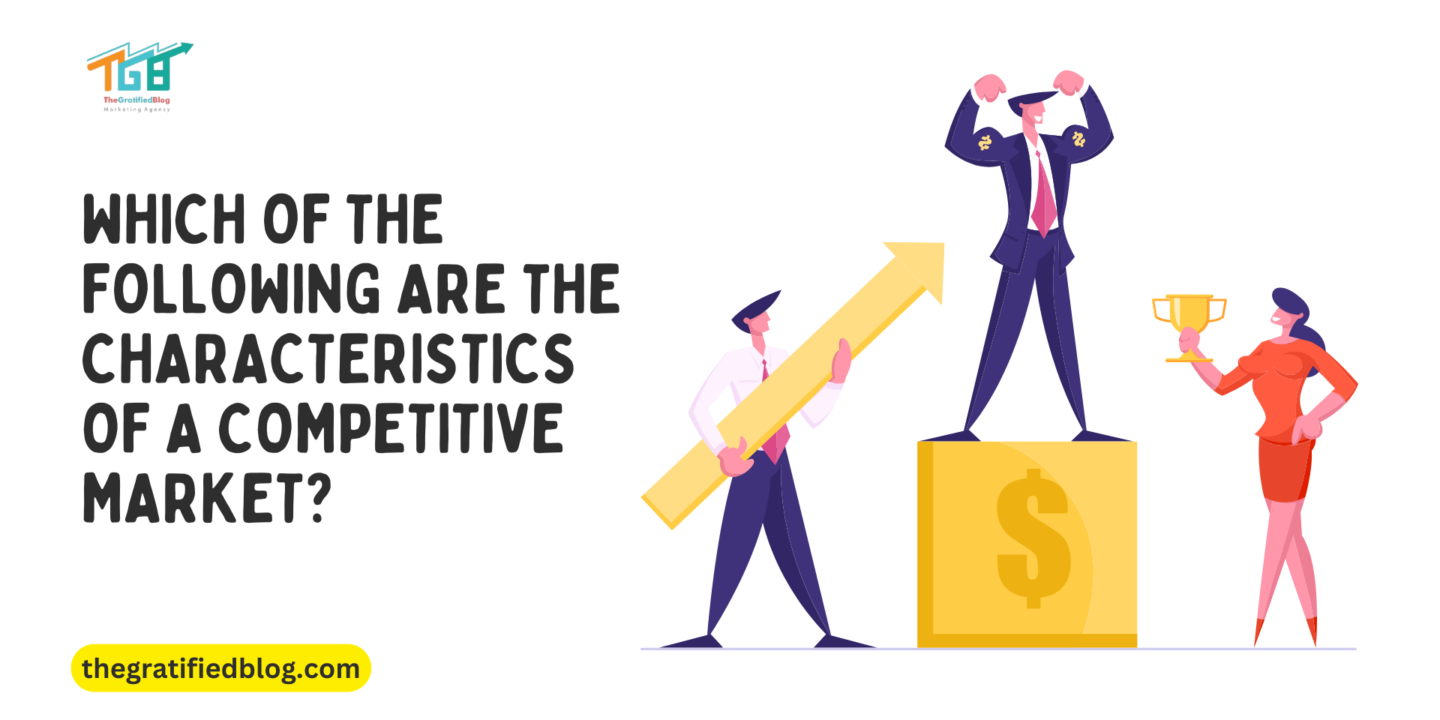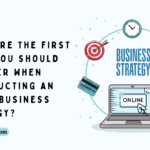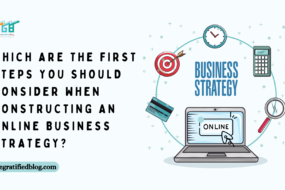
Imagine walking into a marketplace filled with stalls selling fresh fruits, vegetables, clothes, and gadgets. You see vendors trying to attract customers, offering discounts, and showcasing their best products. This is a classic example of a competitive market.
A competitive market is one where many businesses sell similar products or services, and no single seller has full control over the price. This type of market benefits buyers because they get more choices, better prices, and higher-quality products.
But what exactly makes a market competitive? Which of the following are the characteristics of a competitive market? Let us break it down.
What Is A Competitive Market?
A competitive market is an environment where different sellers compete to attract customers. No single company dominates because many businesses offer similar products or services.
For example:
- When you go online to buy a smartphone, you find many brands offering similar features at different price points.
- When you search for a coffee shop, you find plenty of options, from big brands to small local cafes.
In a competitive market, buyers have many choices, and sellers must work hard to stand out. They do this by improving quality, lowering prices, or offering something unique.
Importance Of Understanding Market Competition
Knowing how a competitive market works is important for both businesses and customers.
For Businesses:
- Helps them create better pricing strategies.
- Encourages them to improve quality and service.
- Forces them to stay innovative and efficient.
For Customers:
- Ensures they get fair prices and better options.
- Gives them access to improved products and services.
- Allows them to make informed choices when buying.
When businesses understand competition, they can adjust their strategies and find ways to attract customers. When customers understand competition, they can make smarter shopping decisions.
Types Of Market Competition
Market competition can be categorized into different types based on the number of competitors and the nature of the products or services they offer. Here are the main types:
1. Perfect Competition
This is the most competitive type of market. Many sellers offer nearly identical products, and no single business can influence the price.
- Customers can easily switch between sellers.
- Prices remain low because businesses compete aggressively.
- New businesses can enter or exit the market without difficulty.
2. Monopolistic Competition
In this type of market, many businesses sell similar products but with slight differences. Companies try to stand out by focusing on branding, quality, or extra features.
- Products are not identical but serve the same purpose.
- Businesses compete based on quality, service, or branding.
- Prices are slightly higher than in perfect competition.
3. Oligopoly
An oligopoly is a market where only a few large businesses dominate. These companies control most of the market and influence prices.
- There are only a few major competitors.
- Prices remain stable because companies do not compete aggressively.
- New businesses find it difficult to enter the market due to high costs.
4. Monopoly
A monopoly is the opposite of a competitive market. In this type of market, only one company controls the entire industry.
- There are no direct competitors.
- The business sets its own prices.
- Customers have no alternative options.
Examples Of Competitive Markets
Competitive markets exist in many industries. Here are some common examples:
- Online Shopping: Many e-commerce websites compete for customers, offering discounts, free delivery, and better services.
- Fast Food Industry: Burger chains, pizza outlets, and coffee shops compete by offering new menu items, deals, and loyalty programs.
- Airline Industry: Different airlines compete by offering lower ticket prices, better services, and reward programs.
- Supermarkets And Retail Stores: Big retail brands compete by providing discounts, better quality products, and convenience.
- Mobile Phones: Smartphone brands introduce new technology, features, and pricing to win customers.
Now, let us look at the key characteristics of a competitive market.
Which Of The Following Are The Characteristics Of A Competitive Market?
A competitive market has several defining characteristics that set it apart from other types of markets. Here are the key features:
1. Many Buyers And Sellers
One of the main characteristics of a competitive market is that there are a large number of buyers and sellers.
- Buyers have plenty of options to choose from.
- Sellers compete to attract customers by improving their offerings.
- No single buyer or seller can control the market price.
For example, in the smartphone industry, many companies like Apple, Samsung, and Xiaomi sell similar products. Because of this, no single brand can completely dominate the market.
2. Similar Products Or Services
In a competitive market, the products or services offered by different businesses are very similar.
- Customers can easily switch from one seller to another.
- There is little difference between products, except for minor features or branding.
- Prices remain stable because businesses cannot charge too much without losing customers.
For instance, bottled water is a great example. Whether you buy one brand or another, the product is essentially the same. If one brand raises its price too much, customers will buy from another brand instead.
3. Price Determined By Supply And Demand
In a competitive market, prices are not set by sellers. Instead, they change based on supply and demand.
- If demand is high and supply is low, prices go up.
- If supply is high and demand is low, prices go down.
- Sellers cannot set very high prices because customers will go to a competitor.
For example, during the holiday season, the price of popular toys increases because demand is high. But after the holidays, prices drop because fewer people are buying them.
4. Easy Entry And Exit
A competitive market allows new businesses to enter easily and existing businesses to leave without much trouble.
- New sellers can start a business with fewer restrictions.
- Existing businesses can shut down without major financial loss.
- There are fewer government rules and regulations stopping new competitors.
For example, if you want to start a bakery, you can open a small shop or start selling online. You do not need a huge investment or special permissions, making it easy to enter the market.
5. No Single Seller Has Market Control
In a competitive market, no single seller or business has complete control.
- There are too many competitors for one company to dominate.
- If one business fails, others will quickly take its place.
- Customers do not rely on a single brand or company for a product.
Think about online shopping. If one e-commerce store shuts down, customers can easily buy from another website. There is always an alternative in a competitive market.
6. Perfect Information For Buyers And Sellers
In a competitive market, buyers and sellers have access to all the information they need.
- Customers can compare prices and quality before making a purchase.
- Businesses know what their competitors are offering.
- There are no hidden costs or surprises.
For example, before booking a flight, you can check different airline prices, read customer reviews, and find the best deal. This transparency ensures that no business can overcharge customers without losing them.
7. Businesses Focus On Efficiency
Since competition is high, businesses must work efficiently to survive.
- They try to lower costs to keep prices competitive.
- They look for ways to improve customer service.
- They introduce new ideas to stand out.
For example, fast-food chains constantly improve their service speed because they know customers have many alternatives. If they fail to serve quickly, customers will go elsewhere.
8. Customer Benefits The Most
A competitive market benefits buyers more than anything else.
- Prices remain fair because sellers compete with each other.
- Product quality improves since businesses want to attract more customers.
- There are always multiple choices, giving buyers freedom.
For example, if one internet provider offers slow service, customers can switch to another company. This forces businesses to provide better services to keep customers happy.
9. Innovation And Improvement Are Constant
Since companies want to attract more customers, they constantly try to improve their products or services.
- They introduce new features to stay ahead of competitors.
- They invest in research to create better solutions.
- They offer better deals and discounts to attract buyers.
For example, smartphone brands release new models with better cameras and battery life every year. They know customers want the latest technology, so they keep innovating.
10. Government Plays A Limited Role
In a truly competitive market, the government does not interfere too much.
- Businesses operate freely without too many rules.
- Prices are controlled by competition, not government policies.
- There are fewer restrictions, making it easy to start a business.
For example, street food vendors in many cities operate without too many government restrictions. They set their own prices based on what customers are willing to pay.
Key Factors Driving Market Competition
Several factors influence how competitive a market is. Here are some of the most important ones:
1. Supply And Demand Dynamics
Supply and demand play a major role in shaping competition.
- When demand for a product is high and supply is low, businesses can charge higher prices.
- If there is too much supply and not enough demand, prices drop, and businesses must compete aggressively.
- Market fluctuations force companies to constantly adjust their strategies.
Example: The real estate market often experiences price changes based on supply and demand. If too many houses are available and fewer buyers exist, home prices go down.
2. Consumer Behavior And Preferences
What customers want heavily impacts competition.
- If customers prefer eco-friendly products, businesses must adapt to this demand.
- Brands that offer better service, pricing, or convenience attract more customers.
- Businesses must track customer trends and adjust their offerings to stay competitive.
Example: Streaming services like Netflix and Disney+ compete by offering personalized recommendations and exclusive content based on what users prefer.
3. Technological Advancements
New technology changes the way businesses compete.
- Companies that adopt new technology can improve efficiency and reduce costs.
- Businesses that fail to innovate risk losing customers.
- Digital tools help companies reach wider audiences and increase their competitive edge.
Example: Online shopping has changed retail competition. Companies that invest in better e-commerce platforms gain an advantage over traditional stores.
4. Market Regulations And Policies
Government rules and policies affect market competition.
- Some regulations prevent monopolies and ensure fair pricing.
- High taxes or licensing fees can make it harder for new businesses to enter a market.
- In some industries, strict policies limit how companies can compete.
Example: The airline industry has government rules that control pricing, safety, and customer rights, influencing competition between airlines.
Strategies For Success In A Competitive Market
Since competition is tough, businesses need to adopt smart strategies to stand out. Here are some of the best ways to succeed:
1. Differentiation And Unique Value Proposition
To attract customers, businesses must offer something different from competitors.
- Provide better quality or unique features.
- Focus on excellent customer service.
- Build a strong brand that connects with people.
Example: Apple stands out in the smartphone market by focusing on sleek design and user-friendly software.
2. Pricing Strategies To Stay Competitive
Businesses need smart pricing to attract customers while staying profitable.
- Competitive pricing: Matching or slightly lowering prices compared to competitors.
- Value-based pricing: Charging based on the benefits and quality of the product.
- Discount strategies: Offering seasonal or bulk discounts to attract buyers.
Example: Amazon attracts customers with competitive prices and frequent sales events like Black Friday deals.
3. Leveraging Digital Marketing And Branding
Marketing plays a huge role in standing out in a competitive market.
- Use social media to engage with customers.
- Invest in search engine optimization (SEO) to rank higher in online searches.
- Run email and online ad campaigns to reach a bigger audience.
Example: Coca-Cola uses strong branding and marketing to maintain its position as a leading beverage company.
4. Customer Retention And Loyalty Programs
Keeping existing customers is just as important as attracting new ones.
- Loyalty programs reward repeat customers.
- Excellent customer service keeps buyers happy.
- Personalized offers make customers feel valued.
Example: Starbucks rewards customers with points through its loyalty program, encouraging them to keep coming back.
Challenges Of Competing In A Saturated Market
While competition benefits customers, it can be challenging for businesses. A saturated market makes it harder for companies to stand out and maintain profitability. Here are some major challenges businesses face:
1. Price Wars And Profit Margin Squeeze
- In highly competitive markets, businesses lower their prices to attract customers.
- Price wars reduce profit margins, making it difficult to sustain long-term growth.
- Small businesses struggle to match the pricing power of big companies.
Example: The airline industry often faces price wars, where companies cut ticket prices to attract passengers, reducing profits.
2. Market Entry Barriers
- Some industries have high startup costs, making it tough for new businesses to enter.
- Strong brand loyalty makes it difficult for new companies to gain customers.
- Licensing, legal requirements, and distribution challenges create roadblocks for newcomers.
Example: The smartphone industry has high entry barriers due to massive research, production, and marketing costs.
3. Rapid Industry Changes And Disruptions
- Markets change quickly due to new technology, trends, or economic shifts.
- Businesses must adapt fast to stay relevant.
- Customer preferences evolve, forcing companies to keep innovating.
Example: The taxi industry was disrupted by ride-sharing apps like Uber and Lyft, making traditional taxi companies struggle to compete.
Future Trends In Market Competition
The business world is constantly changing, and new trends continue to shape market competition. Here are some key trends that will influence how businesses compete in the future:
1. AI And Automation Impacting Competition
- Artificial intelligence (AI) is transforming industries by improving efficiency and reducing costs.
- Businesses that adopt automation gain a competitive advantage by speeding up operations and personalizing customer experiences.
- AI-driven chatbots, smart recommendations, and automated processes help companies stay ahead.
Example: E-commerce platforms like Amazon use AI to recommend products based on customer behavior, increasing sales.
2. The Role Of Sustainability In Competitive Advantage
- Customers are becoming more conscious about sustainability and ethical business practices.
- Companies that focus on eco-friendly products, sustainable sourcing, and reducing carbon footprints gain customer trust.
- Governments are also pushing businesses to adopt greener solutions, making sustainability a key factor in competition.
Example: Brands like Tesla and Patagonia have built strong reputations by prioritizing sustainability and ethical business practices.
3. Emerging Markets And Global Expansion
- Companies are expanding beyond their home countries to tap into new customer bases.
- Emerging markets in Asia, Africa, and Latin America present new growth opportunities.
- Businesses that successfully enter new markets must understand local cultures, preferences, and regulations.
Example: Fast-food chains like McDonald’s and KFC have expanded globally by adapting their menus to local tastes.
Final Thoughts
A competitive market creates a win-win situation for both businesses and customers. Companies work harder to provide better products, and customers get more choices at fair prices.
In a world where competition is everywhere, businesses must constantly improve, stay innovative, and keep prices attractive. This is what makes a competitive market so powerful and beneficial for everyone.
So next time you shop for something, whether it is a gadget, clothes, or even a cup of coffee, remember—you are part of a competitive market that keeps businesses on their toes!
Frequently Asked Questions
Q1. Which of the following are the characteristics of a competitive market?
Ans. A competitive market features many buyers and sellers, free entry and exit, standardized products, perfect information, and price-taking behavior. No single participant can control prices, and competition drives efficiency, innovation, and consumer choice.
Q2. What are the main characteristics of a competitive market?
Ans. The main characteristics include numerous buyers and sellers, identical products, ease of market entry and exit, complete information for all participants, and price-taking behavior. These factors ensure that firms compete based on efficiency rather than controlling prices.
Q3. What are the 5 characteristics of a perfectly competitive market?
Ans. A perfectly competitive market has (1) many buyers and sellers, (2) identical products, (3) free market entry and exit, (4) perfect information, and (5) price-taking firms that accept the market price without influence, ensuring efficiency and consumer benefits.
Q4. Which of the following are the characteristics of a competitive market standardized products?
Ans. Yes, standardized products are a key characteristic of a competitive market. Products are identical across suppliers, meaning buyers have no preference for one seller over another. This promotes price competition and ensures firms compete on efficiency rather than product differentiation.








No Comments